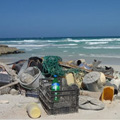The millions of tonnes of plastic ending up in the oceans every year are a global challenge. ESA is responding by looking at the detection of marine plastic litter from space, potentially charting its highest concentrations and understanding the gigantic scale of the problem.
We dump around 10 million tonnes of plastic in the oceans annually. Though most conspicuous along coastlines, plastic litter is also found out in the open ocean and from the equator to the pole – even frozen in polar ice.
Gradually broken down into micro-fragments by weathering and waves, it is not only endangering marine animals but it is also entering the global food chain, with unknown long-term consequences for animal life and our own health.
